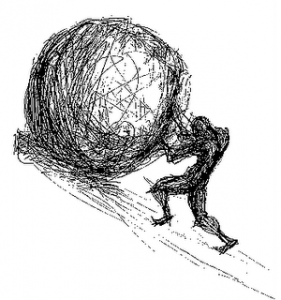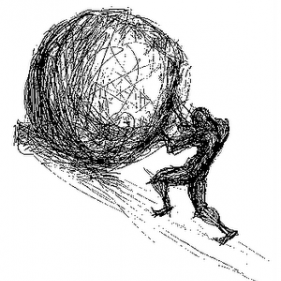Resource Library
The Paradox of Power in 12-Step Recovery
 At the very heart of addiction lies the search for power, control, comfort, relief, and pleasure. At first, the drug is a secret superpower that heals, emboldens, and frees us, but as it feeds on us, it becomes stronger and we become progressively weaker. In the end, we worship the drug at the exclusion of all else as we become one with the drug. We are in its power, feeling more possessed that master of our fate. It is thus little wonder that the issue of personal power is at the center of multiple pathways of addiction recovery.
At the very heart of addiction lies the search for power, control, comfort, relief, and pleasure. At first, the drug is a secret superpower that heals, emboldens, and frees us, but as it feeds on us, it becomes stronger and we become progressively weaker. In the end, we worship the drug at the exclusion of all else as we become one with the drug. We are in its power, feeling more possessed that master of our fate. It is thus little wonder that the issue of personal power is at the center of multiple pathways of addiction recovery.
Mainstream 12-Step recovery, drawn from the experience of first-generation, predominately White male AA members who had lost their personal and cultural empowerment due to alcoholism and the Depression, rests on a deep acceptance of one’s powerlessness. Complete surrender to this state of powerlessness is the beginning and very crux of recovery within the 12-Step program. Later frameworks of recovery, drawn primarily from the collective experience of addicted women, people of color, young people, members of the LGBTQ community, and other historically disenfranchised populations, proffered the assertion of power and control as the central recovery catalyst. These later frameworks also emphasized much greater reliance on discovering power within oneself rather than sole reliance on power beyond the self. (For full discussion, see White and Chaney Metaphors of Transformation.)
Twelve-Step critics, drawn primarily from alternative recovery mutual aid societies and from the professional disciplines of psychology and psychiatry, allege that the core concepts and practices of 12-Step programs are disempowering at personal, cultural, and political levels. On the surface, it would seem that the effect of embracing powerlessness and extolling surrender would result in a lost sense of personal power, but early 12-Step members discovered a remarkable paradox. In the act of openly admitting their powerlessness over a drug (alcohol in A.A.) or a process (addiction in N.A.), they mysteriously acquired an unprecedented level of power and control over their lives. Early 12-Step literature speaks to this: “Such is the paradox of A.A. regeneration: strength arising out of complete defeat and weakness, the loss of one’s old life as a condition for finding a new one.”
Long-tenured members of AA, NA, and other 12-Step fellowships suggest that there is something quite liberating to peel away one’s drug dependence and shed the related monetary extortion and corruption of personal character. In their experience, freedom lies in the clarity that one has not been, is not, and can never be in control of the drug relationship. They argue that the only way to be free of Sisyphean attempts to control the drug relationship is to sever that relationship completely and irrevocably. They also note a sense of exhilaration in the full realization that all they can ever hope to be and do—both duration and quality of life—hinges on one single issue and related daily priority.
While different perspectives on power and powerlessness exist across religious, spiritual, and secular recovery mutual aid organizations, I am most interested in the contrast on these issues that exist between professional service organizations and recovery mutual aid organizations (and more specifically 12-Step organizations). There would seem to be some value in comparing what “empowering” alternatives 12-Step critics have to offer as a solution to severe substance-related problems. In short, what are the major differences in “power” across professional and peer support contexts? I would argue that the peer support context offers considerably more power and freedom than that found in the professional service relationship.
Twelve-Step members control the pace of emotional intimacy through their choice of meeting styles, meeting frequency, degree of socializing outside of meetings, and choice to have or not have a sponsorship relationship and with whom. In the professional context, the service professional prescribes the frequency and intensity of contact. Twelve-Step programs are accessible around the clock, including evenings, weekends, and holidays—something unheard of in the professional context. Twelve-Step programs are geographically accessible even when traveling the world; historically, the professional service relationship is rooted to a single location. There are no fees attached to 12-Step participation—only small volunteer contributions to support maintenance of the group. In contrast, professional recovery support can involve tens of thousands and potentially hundreds of thousands of dollars. Twelve-Step programs maintain no record of one’s support activities; professionals maintain extensive records that are not in control of the “patient.” Peer relationships within 12-Step programs rest on a foundation of reciprocity of support and equality of power; professional relationships are hierarchical with greater power placed in the role of the professional. Twelve-Step relationships are potentially enduring; professional relationships are almost universally time-limited and ever-briefer within the current service funding environment. Where 12-Step programs limit invasiveness and levels of personal disclosure (via discouragement of crosstalk and discouragement of taking other people’s inventories), professional treatment often involves pressure for a heightened degree of personal disclosure.
I do not intend to contrast 12-Step and other mutual aid groups and professional interventions into a binary either/or choice or in a contrasting superiority/inferiority judgment. Both have value as mechanisms of recovery support. I am simply pointing out that people have far more personal power in the recovery mutual aid context than in the professional context. Moreover, it is hypocritical for professionals to castigate 12-Step groups as “disempowering” only to offer an alternative in which individuals have far fewer choices and find themselves at the bottom of a hierarchical service relationship characterized by substantial fees, limited accessibility, and short duration of support followed by what many may experience as “clinical abandonment.”

